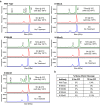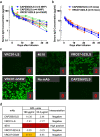Engineering of HIV-1 neutralizing antibody CAP256V2LS for manufacturability and improved half life
- PMID: 36284200
- PMCID: PMC9596707
- DOI: 10.1038/s41598-022-22435-2
Engineering of HIV-1 neutralizing antibody CAP256V2LS for manufacturability and improved half life
Abstract
The broadly neutralizing antibody (bNAb) CAP256-VRC26.25 has exceptional potency against HIV-1 and has been considered for clinical use. During the characterization and production of this bNAb, we observed several unusual features. First, the antibody appeared to adhere to pipette tips, requiring tips to be changed during serial dilution to accurately measure potency. Second, during production scale-up, proteolytic cleavage was discovered to target an extended heavy chain loop, which was attributed to a protease in spent medium from 2-week culture. To enable large scale production, we altered the site of cleavage via a single amino acid change, K100mA. The resultant antibody retained potency and breadth while avoiding protease cleavage. We also added the half-life extending mutation LS, which improved the in vivo persistence in animal models, but did not impact neutralization activity; we observed the same preservation of neutralization for bNAbs VRC01, N6, and PGDM1400 with LS on a 208-virus panel. The final engineered antibody, CAP256V2LS, retained the extraordinary neutralization potency of the parental antibody, had a favorable pharmacokinetic profile in animal models, and was negative in in vitro assessment of autoreactivity. CAP256V2LS has the requisite potency, developability and suitability for scale-up, allowing its advancement as a clinical candidate.
© 2022. This is a U.S. Government work and not under copyright protection in the US; foreign copyright protection may apply.
Conflict of interest statement
NDR, JG, PDK, and JRM are co-inventors on a patent including the CAP256-VRC26.25 antibody, US application 16/718,322 pending. All other authors report no competing interests.
Figures





References
-
- Ivleva VB, Schneck NA, Gollapudi D, Arnold F, Cooper JW, Lei QP. Investigation of sequence clipping and structural heterogeneity of an HIV broadly neutralizing antibody by a comprehensive LC-MS analysis. J. Am. Soc. Mass Spectrom. 2018;29:1512–1523. doi: 10.1007/s13361-018-1968-0. - DOI - PMC - PubMed
Publication types
MeSH terms
Substances
LinkOut - more resources
Full Text Sources
Medical

